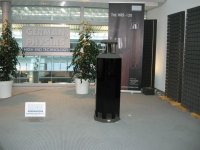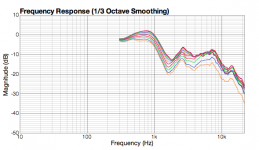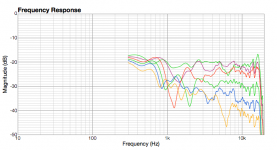Thanx Wayne.....very informative. Would you mind sharing your thoughts on spaces better suited to corner horns? My space could easily 'physically ' accommodate one.....but acoustically?......I will have to defer to your opinions or risk failure through expensive experimentation.
I've listed some links below that hit the high points on constant directivity cornerhorns. But to sum up the "deal breaker" requirements in one sentence, the corners need to be unobstructed for several feet and they need to be spaced so the forward axes cross just in front of the listening area.
- High-Fidelity Uniform-Directivity Loudspeakers
- Speaker placement and wavefront launch
- Imaging, placement and orientation
- Pi Cornerhorns - a brief history
- Corner Pi speakers
- Klipschorn vs seven Pi cornerhorn
- Pi Constant Directivity Cornerhorn: Bass Bin Design Details
- Midrange horn shape in Pi cornerhorn
- Horn/Waveguide dimensions and beamwidth
- Pi Speakers FAQ
- Search results for "Cornerhorns"
Last edited:
Because high DI CD avoids early reflections and yields a direct and reverberant field that has the same spectral balance.
"Avoiding early reflections" and "spectral balance of direct vs. reflected sound" sounds intuitively right but where's the proof that it IS right?
What would be "ideal" IYO?
I don't know. The more I learn and think about the subject the farther the answer seems to move away.
Like sitting close to a pair of omni's.
I've yet to see (hear) a real omni. Linkwitz's Pluto:
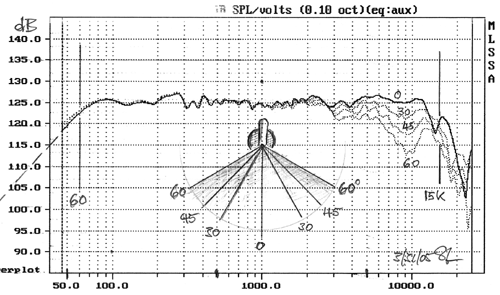
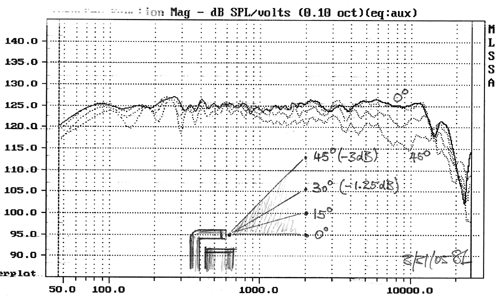
This is NOT omni.
Markus - just the kind of answer that I would expect.
1) Nothing being discussed here has been "proven" and probably can't ever be. The best that we can do is use what we "know" to guide our guesses. "Know" being the key word here - subjective listening is not "knowing", it is opinion. It is far safer to stick with that information that we actually do have a solid understanding of and exclude that which is just someones opinion.
2) You object to almost everything but have no clue what would be any better 😀
1) Nothing being discussed here has been "proven" and probably can't ever be. The best that we can do is use what we "know" to guide our guesses. "Know" being the key word here - subjective listening is not "knowing", it is opinion. It is far safer to stick with that information that we actually do have a solid understanding of and exclude that which is just someones opinion.
2) You object to almost everything but have no clue what would be any better 😀
Yes. I've heard them on a few occasions. Certainly a "fun" sounding speaker, but I'm sure the hot low end and diffuse imaging would get tiresome quickly.I think the MBL stuff is pretty much true omni (horizontally) isn't it?
It sure is. The MBL flagship is has even powerrespons out 90 degrees at a certain height. German Physiks is also omni horizontally.I think the MBL stuff is pretty much true omni (horizontally) isn't it?
Attachments
I think the MBL stuff is pretty much true omni (horizontally) isn't it?
It sure is. The MBL flagship is has even powerrespons out 90 degrees at a certain height.
Any measurements? Everybody almost instantly agrees that the MBL's are omni - I've never seen any polar data.
Last edited:
Horizontal data looks good but vertically?
This is a little experiment I did a while ago with a 8" fullrange driver - just needs some EQ 🙂

(0°-90°)
This is a little experiment I did a while ago with a 8" fullrange driver - just needs some EQ 🙂
(0°-90°)
Attachments
Last edited:
I've yet to see (hear) a real omni. Linkwitz's Pluto:


This is NOT omni.
And just what does the vertical response of your Nathan's look like?
Do you have any polars of your corner horns you could share?I build both DI-matched two-way speakers and constant directivity cornerhorns. In my opinion, a properly built cornerhorn is better than a free-standing two-way speaker when used indoors.
The cornerhorn has the advantage because it is acoustically close to the nearest boundaries so there is no self-interference from them.
A corner horn is coupled to the room. The room function as a waveguide for the LF. So showing a complete polar of a corner horn doesn't really make sense. The room will decide how low it works. Only for the upper frequencies would it make sense to show a polar plot.
I'm sure the polar will collapse some though and start to beam as you get higher.
I'm sure the polar will collapse some though and start to beam as you get higher.
Do you have any polars of your corner horns you could share?
I do, at least a few charts on and off-axis, but they are of an older model that uses a different compression driver and waveguide. Sorry, I don't have any measurements of the current model.
The biggest difference is the compression driver used in the charts below was somewhat peaky and the tweeter horn wasn't quite as good either. This is pretty evident above ~1.2kHz. The tweeter I used back then was radial, so directivity wasn't as uniform as the current model with a waveguide. But the bass bin and midhorn are the same as the current model. So these charts show the LF/MF trend pretty well, and that's what you're after, I suspect.
I used to have access to a tall brick trihedral corner that was outdoors, and this made the perfect place to measure cornerhorns. It is no longer there, so I need to find another place that has this feature, or perhaps make a "portable corner." The measurement system I used back then wasn't all that hot either, but I think it still provided useful information.
Now days, I tend to use LMS outdoors for the measurements I publish, and I use WTPro for development work. When I'm doing design work, I'm mostly concerned with crossover frequencies, and I usually don't publish these pseudo-anechoic test-run measurements. Still, when I changed the waveguide, I confirmed the summing was good between midhorn and tweeter. But again, that has no affect on LF/MF response, so the charts below are still a good representation of current models at low and mid frequency. Still, I want to get new anechoic measurements of the current model cornerhorns using LMS as soon as I can.
In my cornerhorn implementation, the response is pretty much the same at all angles +/-45°. Beyond that, there is no output, because you're in another room. Obviously, some energy passes through the walls, but basically, you have full output throuout the +/-45° arc defined by the wall angle, and nothing outside of it. From the Schroeder frequency up, directivity is constant. There is a slight dip in the on-axis chart between about 100-250Hz, where the bass bin is "shaded". The midhorn and bass bin are blended in this region, so shading isn't bad but there is still about 2dB reduction of output on-axis, and out to about +/-15°.
2002 model seven Pi cornerhorn, on-axis, eighth-space anechoic

2002 model seven Pi cornerhorn, 20° off-axis, eighth-space anechoic
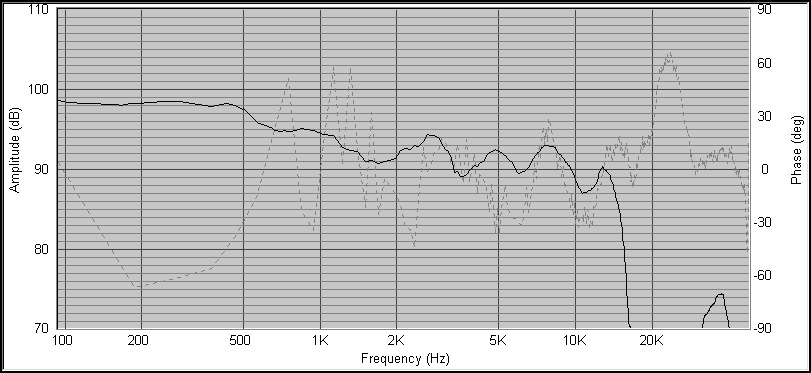
2002 model seven Pi cornerhorn, 40° off-axis, eighth-space anechoic
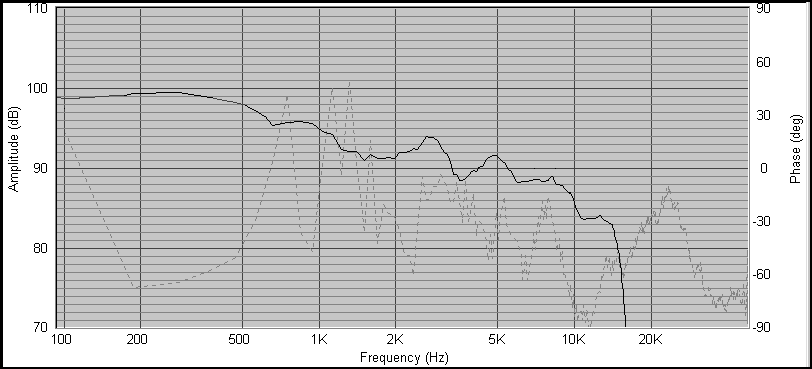

2002 model seven Pi cornerhorn, 20° off-axis, eighth-space anechoic

2002 model seven Pi cornerhorn, 40° off-axis, eighth-space anechoic

One small note: The on-axis chart is about 2dB lower than it should be, and and the 40° chart is about 2dB too high. I should have taken care to match the levels between sweeps, but I didn't. So mentally shift the charts when comparing. They show the response shape pretty well, but not the absolute SPL.
A corner horn is coupled to the room. The room function as a waveguide for the LF. So showing a complete polar of a corner horn doesn't really make sense. The room will decide how low it works. Only for the upper frequencies would it make sense to show a polar plot.
I'm sure the polar will collapse some though and start to beam as you get higher.
This is exactly correct and the reason that I do not think that corner placement is all that great. To be valid the polars would have to be taken with the speaker in a corner just as it is used in practice since this will strongly affect the response. Since no device does not have any radiation outside of its design angle, this radiation bounces off of the walls an interferes with the direct sound. I would expect that the polars would have serious issues in the midband.
I am guessing of course, but without any real data anyone who says otherwise would be guessing as well.
In the picture that you showed before things are even worse. That is because the horn does not actually go all the way to the walls, there is a gap. This gap is likely to be a disaster for a number of reasons.
The way to do this correctly would be to take an Abbey baffle and mount it directly into the corner - no gaps.
This corner placement idea is far from being a proven concept and I suspect that if anyone actually does do the proper measurements they will not look so good.
When the speaker is designed to be free standing and it is placed in the room such that the early reflections are minimized then its direct sound is the free field sound. In the corner placement there is no direct sound which is independent of the walls.
This is exactly correct and the reason that I do not think that corner placement is all that great. To be valid the polars would have to be taken with the speaker in a corner just as it is used in practice since this will strongly affect the response. Since no device does not have any radiation outside of its design angle, this radiation bounces off of the walls an interferes with the direct sound. I would expect that the polars would have serious issues in the midband.
Certainly, all speakers are affected by room modes. But I think most of us agree that the ways to deal with modes at low frequencies is with multisubs. What multisubs don't deal with is anomalies at higher frequencies, self-interference from nearest boundaries. These anomalies can be removed - not just mitigated, but removed - by having the source acoustically close to the boundaries. When the source is flush, there is no self-interference.
In the picture that you showed before things are even worse. That is because the horn does not actually go all the way to the walls, there is a gap. This gap is likely to be a disaster for a number of reasons.
As a matter of acoustic scale, the gaps are probably not significant, in my opinion. Certainly where they are small enough, they are invisible. It's not different than the slight imperfections in the throat or expansion of any horn. I realize you take great care to make the profile precise and smooth the throat, as do I and anyone else concerned with quality. But at some level, there are always imperfections and how much they affect sound quality is a matter of scale.
The way to do this correctly would be to take an Abbey baffle and mount it directly into the corner - no gaps.
I agree, to be sure. Flush mounting is ideal. But I think there is some wiggle room here, more as frequency drops.
In the corner placement there is no direct sound which is independent of the walls.
I suppose you could say that, sure. But then again, this is no different than saying in the horn loaded placement there is no direct sound which is independent of the flare profile. In my opinion, that's a good thing. We benefit from this acoustic device.
And just what does the vertical response of your Nathan's look like?
The question was "how omni are omni designs" and not "how much less omni are other designs".
For what it's worth here's the Nathan's vertical response (resolution about 300Hz).
0°-90° up:
0°-75° down:
By the way, how is your tweeter-ring omni coming along?
Attachments
Last edited:
Markus - just the kind of answer that I would expect.
I don't have anything to sell so I can afford such answers 🙂
1) Nothing being discussed here has been "proven" and probably can't ever be. The best that we can do is use what we "know" to guide our guesses. "Know" being the key word here - subjective listening is not "knowing", it is opinion. It is far safer to stick with that information that we actually do have a solid understanding of and exclude that which is just someones opinion.
Exactly what I'm trying to do.
2) You object to almost everything but have no clue what would be any better 😀
"Almost" - thanks for noticing 🙂 With regards to "having no clue": I have yet to meet that one person that has a clue. Lots of issues in sound reproduction are simply not well understood - by no one. Of course there are lots of people that believe they do. But I'm not very much into religion.
These anomalies can be removed - not just mitigated, but removed - by having the source acoustically close to the boundaries. When the source is flush, there is no self-interference.
Wayne - this is simply not true. Any source acts different near a wall even if it is embedded in that wall.
The rest of your comments are all guesses as well - ones that I don't agree with.
I don't have anything to sell so I can afford such answers 🙂
Yea, the minute your try and sell your designs you lose all the knowledge that you had before you tried to do that.
- Status
- Not open for further replies.
- Home
- Loudspeakers
- Multi-Way
- Uniform Directivity - How important is it?
